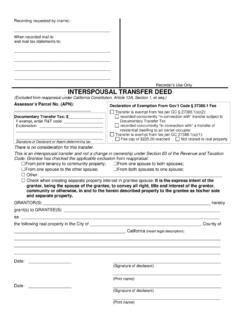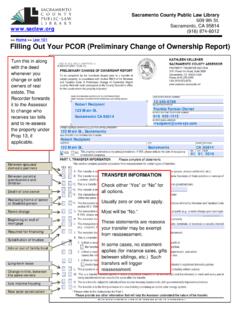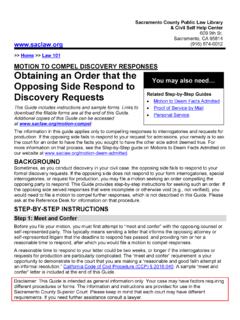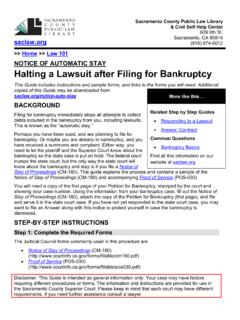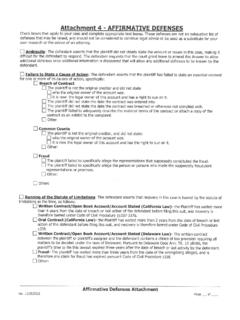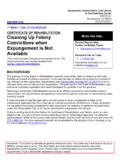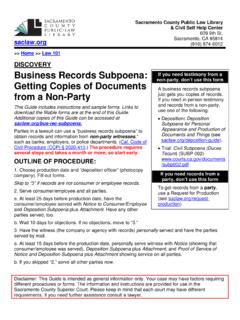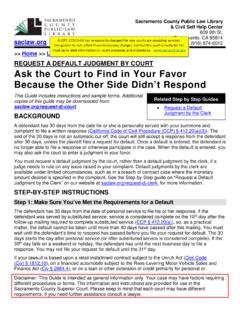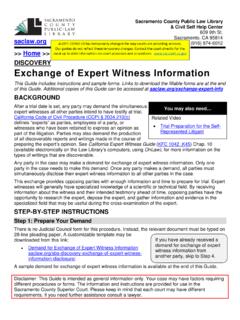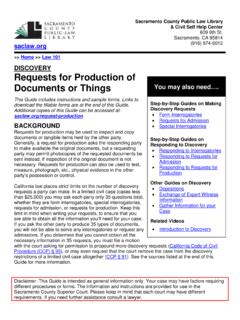Transcription of Completing and Recording Deeds - saclaw.org
1 >> Home >> Law 101 Disclaimer: This Guide is intended as general information only. Your case may have factors requiring different procedures or forms. The information and instructions are provided for use in the Sacramento County Superior Court. Please keep in mind that each court may have different requirements. If you need further assistance consult a lawyer. Sacramento County Public Law Library & Civil Self Help Center 609 9th St. Sacramento, CA 95814 (916) 874-6012 Completing AND Recording Deeds Adding or Changing Names on Property This Guide includes instructions and sample forms. Copies of this Guide and related forms may be downloaded from: BACKGROUND Any time owners make a change to the title of real estate, they must record a deed with the County Recorder.
2 This Step-by-Step guide outlines the requirements and provides samples with instructions. California mainly uses two types of Deeds : the grant deed and the quitclaim deed . Most other Deeds you will see, such as the common interspousal transfer deed , are versions of grant or quitclaim Deeds customized for specific circumstances. Since the interspousal deed is so commonly requested, we are including a sample in this guide. A grant deed is used when a person who is on the current deed transfers ownership or adds a name to a deed . The grantor(s) promise that they currently own the property and that there are no hidden liens or mortgages. A quitclaim deed (sometimes misspelled quick claim ) is used when someone gives up (waives or disclaims) ownership rights in favor of another person.
3 The grantor may or may not be on the current deed . A quitclaim deed is often used in divorces or inheritance situations, when a spouse or heir gives up any potential rights to real estate. The grantor is giving up their own rights, if any, but not promising anything else. An interspousal deed is used between spouses or registered domestic partners ( DP ) to change real estate to or from community property. Spouses/DPs can use grant or quitclaim Deeds to do the same things, but the interspousal deed makes it clear that the transaction is intended to affect community property rights. Warning about adding names If you add a name or sign a quitclaim deed , the grantee becomes an owner. You can t change your mind without their signature. If you are adding them as part of a credit repair or loan deal, it may be a scam.
4 If you are adding an heir, a living trust or Transfer on Death deed lets you name them to inherit without giving up control. Transfers after Death This guide does not cover changes due to the death of a property owner. You will need either an Affidavit of Death or a probate order in such cases. Completing and Recording Deeds >>Home >>Law 1012 STEP BY STEP INSTRUCTIONS Step 1: Locate the Current deed for the Property You will need information from the current deed . If you need a copy of the current deed , contact the Recorder s Office where the property is located. In Sacramento, call (916) 874-6334. Step 2: Determine What Type of deed to Fill Out for Your Situation To transfer ownership, disclaim ownership, or add someone to title, you will choose between a grant deed and a quitclaim deed .
5 Spouses/domestic partners transferring property between each other may choose an interspousal deed . Blank Deeds are available at The deed I need is not on your list! Warranty, joint tenancy , easement, etc. In a warranty deed , the grantor promises to pay for any lawsuits or damages due to undisclosed ownership disputes. In California, title insurance usually covers such disputes. Other types of Deeds , such as joint tenancy Deeds , corporation Deeds , easement Deeds , or mineral rightsdeeds, are usually customized grant Deeds . You can customize our grant deed format for most of them. Consult an attorney or come to the Law Library to research appropriate wording. Completing and Recording Deeds >>Home >>Law 1013 Step 3: Determine How New Owners Will Take Title One, unmarried owner: leave blank If there is only one new owner, and that person is unmarried, title can usually be left blank, although it doesn t hurt to state a single person or a widow or the like.
6 If there is more than one new owner, you are moving the real estate into or out of a trust, or the new owner is married, the form of title can have important effects. More than one owner: owners are not a married couple or registered domestic partners (DP). Ex.: relatives who inherit property together, business partners, couples who are not married/DP. T enants in common (When one dies, their heirs get theirshare; probate may be needed. Shares do not need to beequal. Any owner can sell or mortgage their portion.) joint tenants (When one dies, the other gets 100%automatically. Shares must be equal. Any owner can sell ormortgage their portion.)If you leave this blank, the default is tenants in common. For married couples and registered domestic partners, if both own the property, the choices are C ommunity property (Both must agree to sell or mortgage.)
7 A t death, 50% to survivingspouse/DP, 50% to heirs) Community property with rights of survivorship (WROS) (Both must agree to sell ormortgage. A t death, 100% to surviving spouse/DP.) joint tenants (When one dies, the other gets 100%. Shares must be equal. Either spouse/DPcan sell their portion. May receive less favorable tax treatment when first spouse/DP dies.)If you leave this blank, the default is community property. There are more advantages and disadvantages to each form of title. Your choice of title can have many effects later, such as when you sell, when one spouse/DP passes away, or if you divorce, including: higher property taxes higher capital gains taxes how the property would be divided in a divorce whether the property can be seized or liened for one spouse/DP s separate you have questions about which form of title to use, talk to a family or estate lawyer or research your options at the law library.
8 If only one spouse/DP owns the property (because that person already owned it when they got married or it was a gift or inheritance), they can make that clear by using the phrase as his or her sole and separate property. Note that if any money earned during the marriage is spent to purchase, make mortgage payments, maintain, or improve the house, the community owns a share regardless of what it says on the deed . But I m Not a Tenant! Tenant in common and joint tenant are just old-fashioned phrases that lawyers still use. In this context they refer to the owners. Completing and Recording Deeds >>Home >>Law 1014 Completing and Recording Deeds >>Home >>Law 1015 Step 4: Fill Out the New deed (Do Not Sign) Filled-out samples of each type of deed are attached at the end of this guide.
9 The deed should be filled out online, typed, or neatly written in dark blue or black ink. You will need the following information: Assessor s Parcel Number. Document Transfer Tax amount or exemption code. Names of grantors (the current owner(s) signing the deed ) or of the disclaiming party(ies). Names of grantees (all new and continuing owners).Important: If you add a name, that person legally becomes an owner. You cannot change your mind without their signature. Form of title the grantees will use (for grant and interspousal Deeds ). The legal description of the property. Here are some common issues while filling out Deeds . Documentary Transfer Tax When property changes hands, the county charges a one-time tax of $.55 per $500 of the value of the real estate ( ). Some kinds of transfers are exempt.
10 If yours is exempt, enter the Revenue and Taxation code that provides the exemption, and an explanation, then sign. If yours is not exempt, calculate the dollar amount and write it in. Common exemption codes and explanations: Gift (transferring property, or adding name to property,without compensation):Code: R&T 11911 Explanation: Gift. Living Trust (transfer into or out of revocable living trust):Code: R&T 11930 Explanation: Transfer into or out of atrust Name Change (confirming name change after marriage or court-ordered name change):Code: R&T 11925 Explanation: Confirming change of name, the grantor and grantee are thesame party. Conveyances in dissolution of marriage:Code: R&T 11927 Explanation: Dissolution of marriage. Other exemptions are available. See the list of Transfer Tax Exemptions on the Sacramento Recorder s website at Note: as of January, 2018, there is an additional $75 fee on mortgage refinances and other real estate transactions that are exempt from Documentary Transfer Tax.
